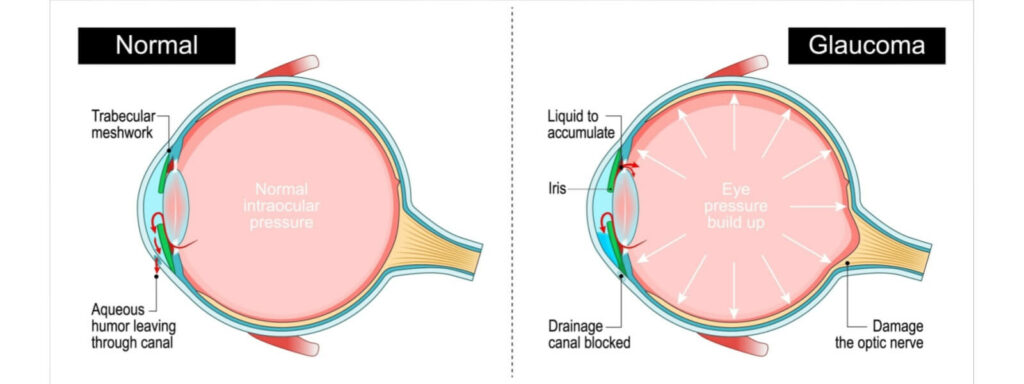Glaucoma is one of the leading causes of vision loss in Canada. It often develops without noticeable symptoms and can go unnoticed until extensive damage occurs.
There are many risk factors for glaucoma, and while it’s not always hereditary, having a close family member with the disease can increase your chances of developing it.
If glaucoma is common in your family, it’s important to take proactive steps to protect your vision.
Glaucoma & Genetic Risk
Glaucoma is strongly influenced by genetics, and a family history of the condition can significantly increase your risk. The most common type of glaucoma, primary open-angle glaucoma, is hereditary, meaning it can run in families. In fact, individuals with immediate family members who have glaucoma are 4 to 9 times more likely to develop it themselves.
However, genetics is only part of the picture. While specific genes have been linked to glaucoma, having those genes doesn’t guarantee you will develop the disease. Other factors—including age, high blood pressure, eye injuries, and myopia (nearsightedness)—can also affect your risk. It’s a mix of genetic predisposition and lifestyle or health factors that determines your risk.
If glaucoma is common in your family, there’s no need to panic. By discussing your family history with your eye doctor and scheduling regular eye exams, you can stay ahead of potential problems. Early detection and proper management are key; with the right care, glaucoma can often be controlled before it causes significant damage.
Types of Glaucoma
There are several types of glaucoma. Glaucoma is generally categorized as primary or secondary and can be further classified by the specific type.
Primary Glaucoma
Primary glaucoma is when the condition develops without any identifiable underlying cause or associated eye disease. In these cases, glaucoma occurs independently, without being triggered by another health issue like trauma or another eye condition.
Types of primary glaucoma include:
- Open-angle glaucoma: This is the most common type of glaucoma. It occurs when the drainage canals in the eye become clogged, leading to increased eye pressure.
- Normal-tension glaucoma: In this type of glaucoma, the optic nerve is damaged even though the eye pressure remains within normal range. The exact cause is unclear, but it may be related to poor blood flow to the optic nerve.
- Angle-closure glaucoma: This is a less common type of glaucoma that occurs when the iris blocks the drainage canals in the eye, causing a sudden increase in eye pressure.
- Congenital glaucoma: This type of glaucoma is present at birth and is caused by a malformation in the eye’s drainage system.

Secondary Glaucoma
Secondary glaucoma occurs when another condition, injury, or disease affects the eye or its drainage system. When something causes a blockage in the eye’s drainage angle or affects fluid outflow, it can increase intraocular pressure and lead to glaucoma.
Secondary glaucoma can be caused by:
- Eye injuries or trauma to the eye
- Inflammatory diseases (like uveitis)
- Medications, such as steroids
- Systemic conditions, such as diabetes
- Or other eye diseases, such as cataracts
In secondary glaucoma, the glaucoma is “secondary” to these other factors, meaning it is a consequence of a pre-existing condition.
How Is Glaucoma Diagnosed?
Glaucoma can only be diagnosed with a comprehensive eye exam. A thorough eye examination includes standard tests specifically designed to detect glaucoma, such as:
- Measuring eye pressure
- Evaluating the health of your optic nerve
- Assessing the drainage angle of the eye
- Testing peripheral (side) vision
These tests help determine whether you are at risk for glaucoma and allow for early detection if the condition is developing.
If your eye exam shows factors indicating a higher risk for glaucoma—such as elevated eye pressure, optic nerve changes, or other early warning signs—you may be considered a glaucoma suspect. This means that while you may not have full-blown glaucoma yet, you have signs that warrant closer monitoring.
Being a glaucoma suspect doesn’t necessarily mean you will develop glaucoma, but it does mean that more frequent eye exams are important to track changes in your eyes and catch the condition before it causes significant damage.
Since glaucoma can develop slowly and often without noticeable symptoms, regular eye exams are crucial for everyone. Early detection and proactive monitoring are key to preserving your vision and managing the condition effectively.
How Is Glaucoma Managed?
There is currently no cure for glaucoma, and any vision loss associated with it is permanent. However, if caught early enough, glaucoma can be managed through several techniques.
The first line of management is generally medicated eye drops to reduce internal eye pressure. If these drops aren’t effective or cause adverse effects, you may be referred to an ophthalmologist for surgery. Surgeries include:
- Laser trabeculoplasty surgery to open drainage canals in the eye.
- Trabeculectomy surgery to create a new drainage channel.
- Laser peripheral iridotomy surgery to create a hole in the iris and improve fluid flow.
- Minimally invasive glaucoma surgery (MIGS) that uses microscopic devices to improve fluid outflow and reduce pressure.
Lifestyle changes like quitting smoking, exercising, and controlling blood pressure can also help manage glaucoma but should not be considered a replacement for medical management.
It’s important to work closely with your eye doctor to determine the best course of treatment for you. They will monitor your condition regularly and adjust as needed to keep your eyes healthy.
Get Support for Glaucoma
If glaucoma is a known issue in your family, it’s vital to communicate with your family members. Sharing information about eye health and encouraging regular check-ups can benefit everyone. Knowledge is power, and understanding your family’s health history can be a game-changer.
Our team at Vivid Eye Care prioritizes early detection and effective management of glaucoma to protect your long-term visual health. If you have questions or need help, book an appointment today.






















